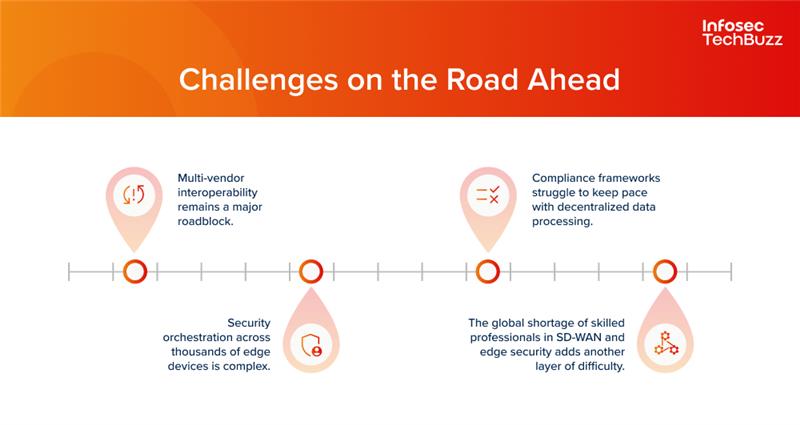To paraphrase Mark Twain, the reports of the impending death of SD-WAN following the rise of hybrid/remote work have been exaggerated. Its ability to connect distributed infrastructure, enabling direct, intelligent cloud connection, and providing network visibility ensure the technology remains popular and has adapted to include provisions like zero trust and next-generation firewalls. The second technology we are talking about here, edge networking, helps provide better internet speeds by coming closer to the point of origin of the data, and has many other benefits. Thus, the integration of these two technologies makes sense. SD-WAN helps distributed workplaces to centralize control and ensure effective policy enforcement, while edge allows decentralized data processing.
WAN found WANting
Global enterprises are now distributed behemoths. Everything is now distributed, with workloads scattered across regions, software delivery models, and device types. Enterprises need agile, secure, and scalable networking solutions to keep up with hybrid work, increased cloud adoption, IoT proliferation, and the rise of distributed applications. Traditional WAN models, focusing on data centers, predictable traffic levels, and work from office models, are insufficient to cope with current needs. There is also an increasing preference for low latency and bandwidth costs due to IoT, AI inferencing, and real-time analytics. Edge can easily solve this problem, as it ensures low latency by keeping the endpoints closer to their physical point of origin. But what about the need to manage thousands of distributed edge nodes? This is one more area that traditional WAN systems were never designed for.

Dropping old connections
As we have stated above, connections themselves have evolved. Today, companies increasingly need agile, secure, and scalable networking solutions because of modern trends like hybrid work, increased cloud and IoT adoption, and the rise of distributed applications. Organizations need enhanced visibility into networking operations to enable digital transformation and the use of next-gen business applications. SD-WAN helps achieve this objective by offering dynamic, software-defined control over how traffic moves between network devices, branches, clouds, and data centers. The solutions provide centralized network control and security through the inclusion of various tools, including firewalls, intrusion prevention, and zero-trust solutions to protect distributed users and IoT endpoints.
Kaushik Vijay Venkatesh, Principal Analyst at QKS Group, explains, “The evolution of SD-WAN is always tied towards simplification and operation management of network nodes from a centralized console. So, the increased nodes across the disparate locations are eventually bound to be connected with the centralized connectivity management tool and orchestrated from a single source of truth. This eventually improves network operations, reduces blind spots, and maintains a secure and seamless network connectivity, across the entire fleet of organizational devices to improve the employees’ overall digital experience.”
Why converge?
If you have come this far, it should be perfectly clear to you why the integration of SD-WAN and Edge is the way forward. SD-WAN + Edge help unify network management and security, reduce network complexity, adapt to business needs, and offer instant network scaling for cloud and branch connectivity in real time. In simpler terms, SD-WAN centralizes control and policy enforcement while allowing decentralized data processing at the edge. The integration, thus, helps deliver performance, flexibility, and security through a single framework. Another factor driving the integration is the rise in adoption of 5G and private networks. The SD-WAN and Edge integration will allow companies to perform data processing for seamless application operations globally while maintaining consistent security and visibility of network operations. In this setup, the edge nodes act as micro data centers, and SD-WAN provides orchestrated connectivity.
The big “S”
The integration does have its own problems, but the solution is also available. The attack surface expands as nodes and network links keep getting added. The issue can be sorted through SASE (Secure Access Service Edge). This architecture blends SD-WAN with cloud-native security services, such as Zero Trust Network Access (ZTNA), firewall-as-a-service, and data protection. Companies can also apply Zero Trust principles at every node and data-in-motion encryption across all tunnels. These will allow companies to maintain visibility and control even in decentralized environments. Unified management planes further reduce blind spots and operational overhead.
Final word
Should we write off a technology just because the key circumstances that necessitated its implementation? This is especially pertinent when it comes to SD-WAN. The SD-WAN technology raised security concerns when the WFH-remote work trend began to take off. However, in this particular case, the vendors quickly enhanced the technology by adding zero trust architecture and adding tools like SASE. The modern SD-WAN solutions, especially when integrated with Edge, when treated as a strategic investment and not a technical afterthought will allow enterprises to shape their networked future.
[KV1]I am not able to understand what Next Gen Business application. Are you refering to applications with embedded AI in it cores, to simplify the use case support for the organization or something else?
[KV2]It should be control rather than security. Please recheck this
[KV1]I am not able to understand what Next Gen Business application. Are you refering to applications with embedded AI in it cores, to simplify the use case support for the organization or something else?

